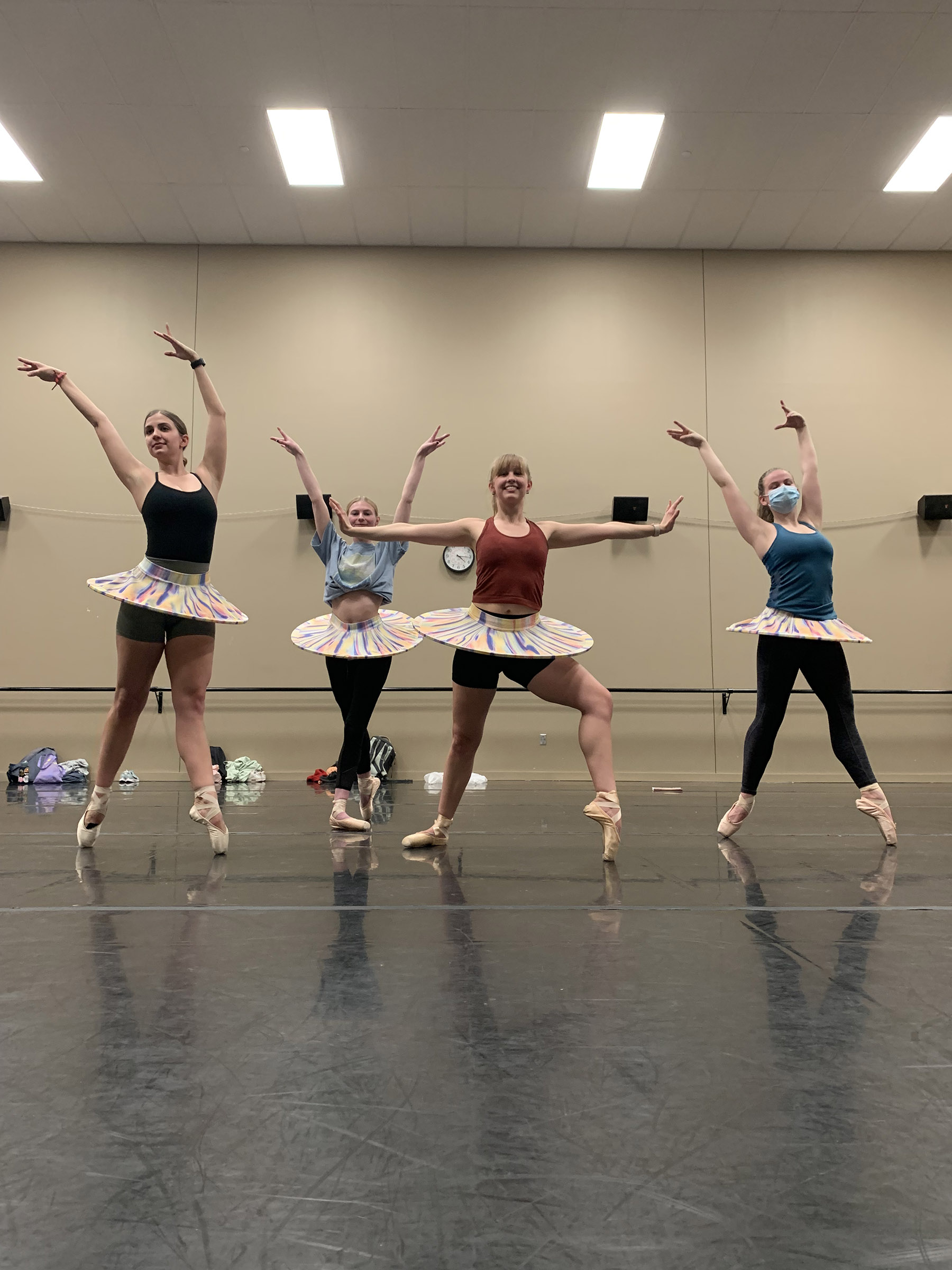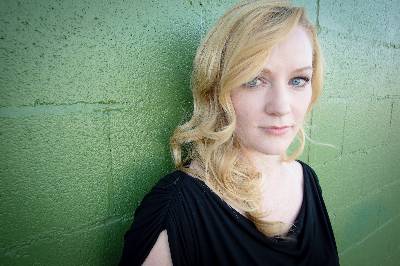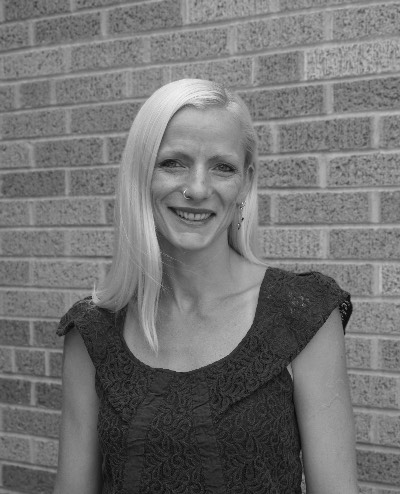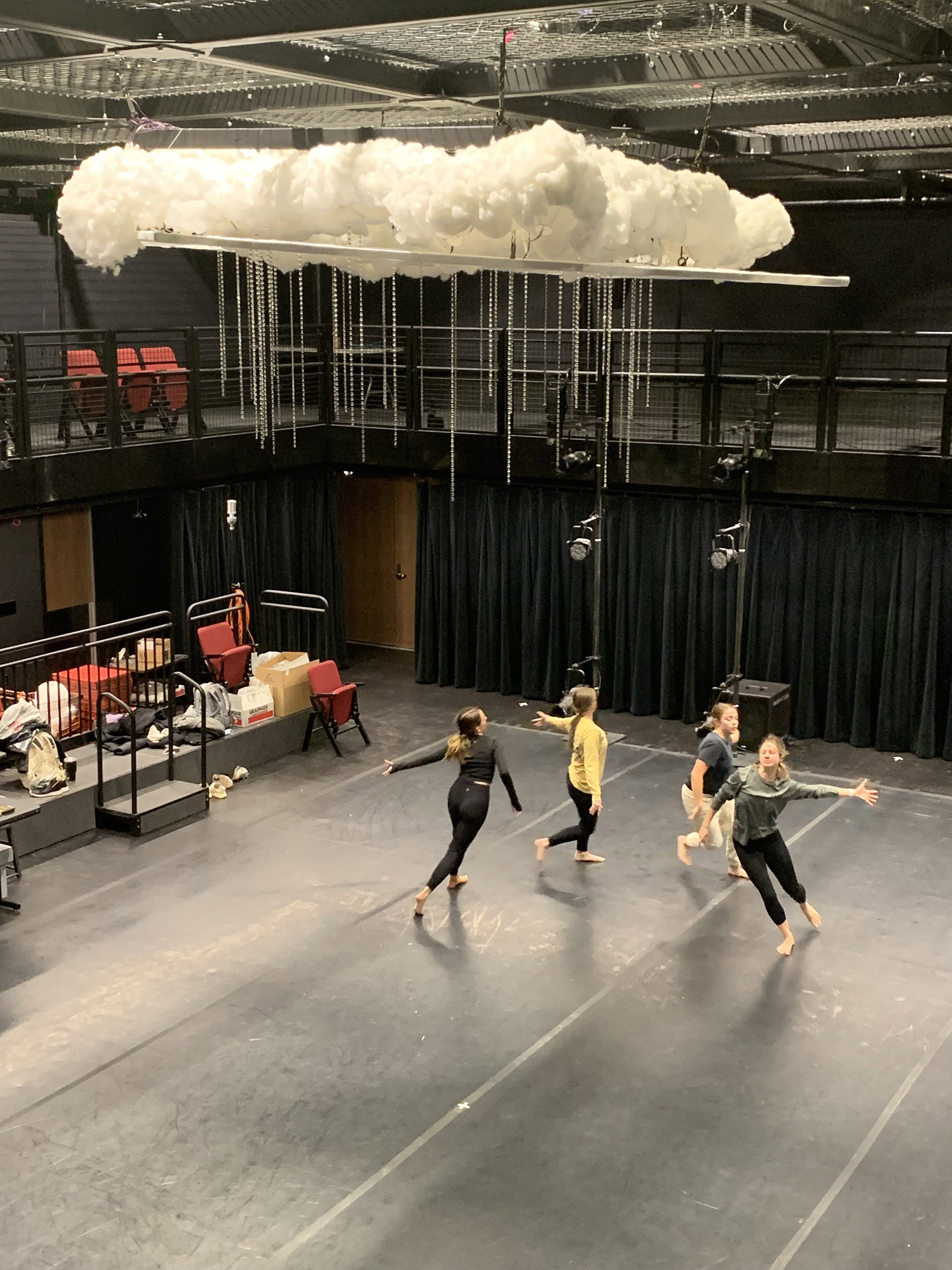
The last time I interviewed Kyla Olson, it was two years ago to explore how dance
was navigating the transition to virtual classes and performance. Today, I was able
to meet with her and Dr. Tanya Calamoneri to discuss the transition back to live performance
and the upcoming production of DanceTech.
Q: Let's start at the beginning. What is DanceTech and how does the process begin for you?
 Kyla: DanceTech is a series of choreographed dance performances, less than an hour total, each with
its own choreographer who is responding to a one-word prompt. There are six pieces,
and I'm choreographing two of them because I like to challenge myself! The choreographers
set their rehearsal schedules ahead of time, and we cast talented dancers who are
available for our specific rehearsals.
Kyla: DanceTech is a series of choreographed dance performances, less than an hour total, each with
its own choreographer who is responding to a one-word prompt. There are six pieces,
and I'm choreographing two of them because I like to challenge myself! The choreographers
set their rehearsal schedules ahead of time, and we cast talented dancers who are
available for our specific rehearsals.
Q: Tech's season this year is entitled “Awakening.” How do you respond to this prompt
in your piece(s)?
Kyla: We have many different choreographers, each interpreting “Awakening” in different ways— some spiritual others, literal. My first piece is called “Altered States.” It's contemporary ballet, and my four dancers are exploring different brain waves. My second piece is called “we in the dark found light.” It's based on a poem, and the five dancers are exploring how light guides our lives. Perhaps it's tied to the shift from “pandemic” performance to in-person performance. Plants grow in sunlight.
 Tanya: My piece relates to awakening in that it's examining the mental states and demons
that plague our thought process, the chatter of the brain. It's called “Hyakki Yakō:
Night Parade of 100 Demons,” and it's related to Japanese folklore, essentially a
cautionary tale to not venture too close to the forest at night. I wanted to explore
the edge of consciousness, and how far we push ourselves into the unknown and what
scares us. The piece is in low light; in low lighting, we see half-truths that may
scare us.
Tanya: My piece relates to awakening in that it's examining the mental states and demons
that plague our thought process, the chatter of the brain. It's called “Hyakki Yakō:
Night Parade of 100 Demons,” and it's related to Japanese folklore, essentially a
cautionary tale to not venture too close to the forest at night. I wanted to explore
the edge of consciousness, and how far we push ourselves into the unknown and what
scares us. The piece is in low light; in low lighting, we see half-truths that may
scare us.
Q: For DanceTech, the black box theatre is set up in an alley staging, with the audience on two sides
of the dancers. How does this layout affect your choreography?
Kyla: It's always a good challenge for the students to shift away from traditional proscenium staging. It allows dancers to become accustomed to multiple layouts and send their energy up and out. I haven't choreographed in an alley setup besides a site-specific piece a couple years ago. It's a welcome change.
Tanya: We have done films, site specific work, and now we're back in the theater! But we're
not in a proscenium. The alley design is a surprise – a shift in perspective, a new
type of challenge. In the past few years, obstacles have prepared us for new challenges,
including this one. As for my choreography, I started to walk around the dancers to
make sure that it looks great from all sides. I mostly realized, “Yeah, looks good
from over here too!”
Q: The DanceTech program lists Tanya Calamoneri as the director of her piece rather
than the choreographer, and it lists both Kyla Olson and the performers as the choreographers
of their pieces. What is the reasoning behind that?
Kyla: I wanted to cast as many dancers as possible, and intentionally chose two smaller works with dancers whose skills fit well together. One piece is contemporary ballet, and the other is contemporary. When I created these pieces, I catered them to the dancers I cast. This is a different way of working for me, and a new challenge for them too. I've been collaborating with them, using their unique skills and limitations to choreograph alongside them.
Tanya: I always work in a devised way. This time, I see myself as a director rather than
a choreographer. I've given the dancers a prompt with phrases, and then draw the choreography
from them. This process encourages them to be true to their bodies. The piece is being
told through my lens, but it's our story. Also, this is both contemporary dance and
physical theater. I've been working with Justin Krall as one of my dancers, and we've
added fight choreography elements. It's all dance. Fight choreography is dance. The
movement in the piece has an edginess to it. There are leaps and kicks and punches.
It's all ways to work with contact or the appearance of contact. So as a director,
I've had to talk with my actors/dancers about intention and physical states. I've
given them reason to move from place to place. The music is a third scene partner.
Q: Are there any technical elements that excite you?
 Kyla: For “we in the dark found light,” there are improvised lighting elements that the
dancers react to organically and in the moment. Ebony Madry, our guest artist lighting
designer, creates impromptu lighting cues to which the dancers respond. Normally,
the dance dictates what lighting choices are made, so I'm eager to work with Ebony
and I'm curious to use her art as the basis for the piece. Essentially, the piece
has improvisational elements that will ensure it will be different each night, so
each audience gets a one-of-a-kind, sort of “bespoke” performance.
Kyla: For “we in the dark found light,” there are improvised lighting elements that the
dancers react to organically and in the moment. Ebony Madry, our guest artist lighting
designer, creates impromptu lighting cues to which the dancers respond. Normally,
the dance dictates what lighting choices are made, so I'm eager to work with Ebony
and I'm curious to use her art as the basis for the piece. Essentially, the piece
has improvisational elements that will ensure it will be different each night, so
each audience gets a one-of-a-kind, sort of “bespoke” performance.
Tanya: We are using handheld lights. The dancers manipulate the lights with their body.
We start in dim light and add small elements of light and sound. Seth Warren-Crow
(associate professor in sound design) has worked with the dancers on percussion in
the piece. I also choreographed the piece first, then handed it to Seth to create
music. We fine-tuned the choreography based on the music he created.
Q: What excites you about the other choreographers and pieces in DanceTech this year?
Kyla: We all move and work in different ways, so we'll be getting a full spectrum from the other choreographers. Kevin Guy is a visiting professor this year, and his work deconstructs social dance forms from different time periods— it's unlike anything else done here. Amanda K Miller, a guest artist who visited in January for five days, works in an improvised process. There is a lot of call and response. Then there's YNOT, who is visiting faculty this spring. You'll just have to wait and see his work. We're ending with his piece, “Atmos,” so that's exciting. It's hip-hop with breaking put into it, and original music that he mixed.
Tanya: The costumes in the other pieces look awesome. YNOT's piece was done in residency
last semester. It may have changed since then, but I heard something about his dancers
spray-painting their own costumes. Our guest choreographers have a different way of
moving through life. It's like a dream world into which we are invited.
Q: How do you personally measure the success of your piece as a choreographer?
Kyla: As a choreographer, I'm always trying to tell a story and get something across to the audience. Even if they don't fully get it, they have a “feeling.” And that has come across to the dancers too because they're the instrument through which I'm speaking. Beautiful dancing is great, but the connection with them and the creative process to build something is the success. The success asks them to reflect on the work they're doing and to have them add their own interpretation.
Tanya: At a certain point, you give the piece over to the dancers. If they can live within
it and give it life, that's the success. I've shared my vision with them, along with
my intention and my background with the piece. Now they're beyond just memorizing
it— they're living in it. Also, if a single audience member can be moved by the piece,
that's a success too. We create to share, after all. Some people may very well just
think, “Ooh, that's cool and creepy movement,” but I would love to reach one person
in a unique way.
Q: What is something you want the audience to know or consider when coming to see the
performances?
Kyla: This will be DanceTech's first time back in the black box since March 2020. Making dance for film is very different from making choreography and then filming it. Now we're back to being in-person. We should appreciate that. It's all about associating music with the dance and making your own story. That's the beauty of dance — you can take so much from it. I'm not trying to tell literal stories, but to evoke emotions that transform you somewhere else in the space. Life is rough and we're still in a pandemic. Audiences need this escapism.
Tanya: I prefer to not go for the “beauty” of dance, and instead push into the ugly. We, as humans, quickly categorize things and make judgments. Allow space for the full range of your reactions. Do not immediately go with “I like it” or “I don't like it.” Let it sit with you. Maybe it will stay with you, maybe it won't. But have space for it. Stay curious!
